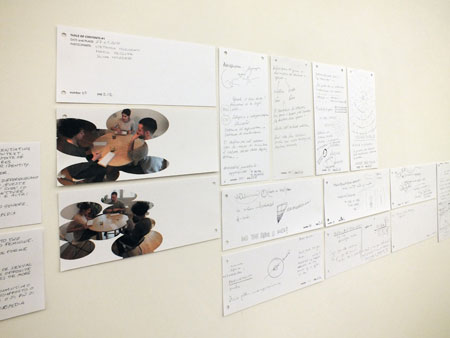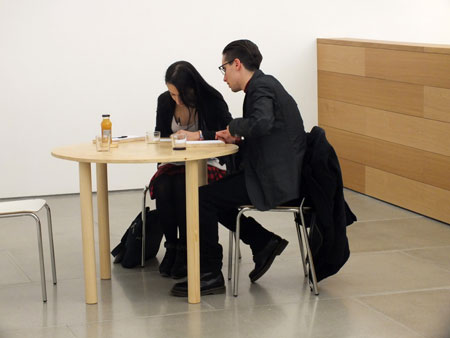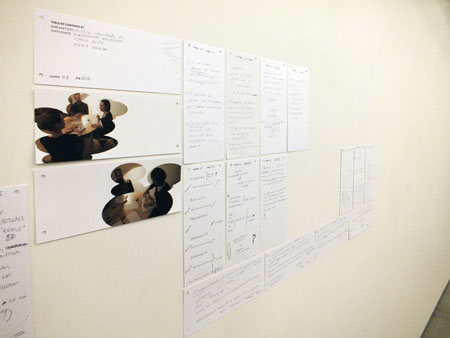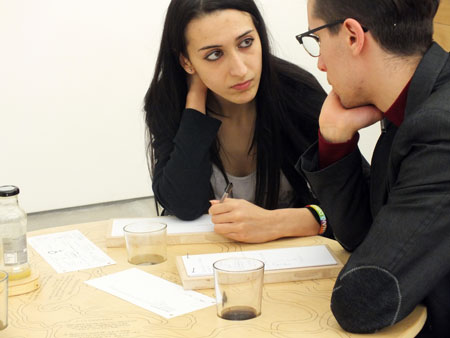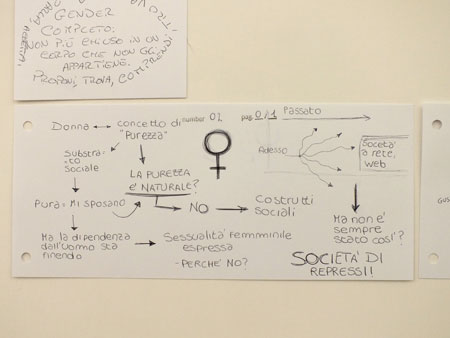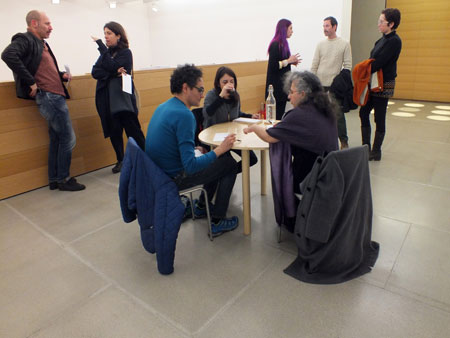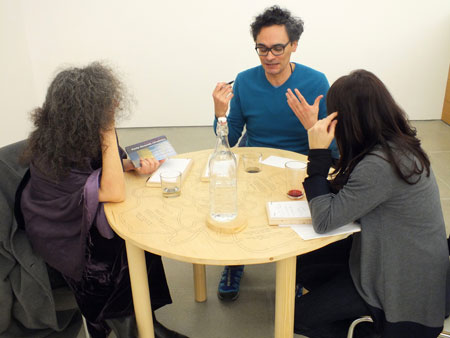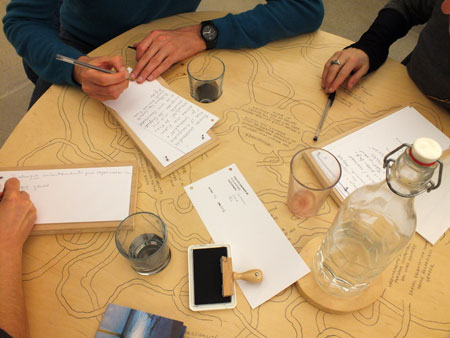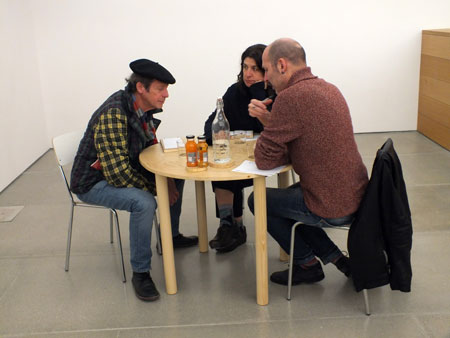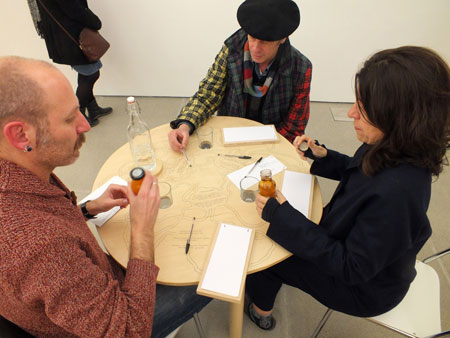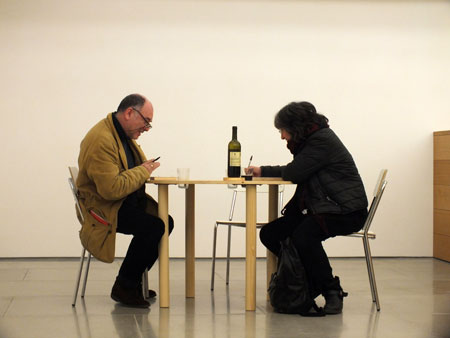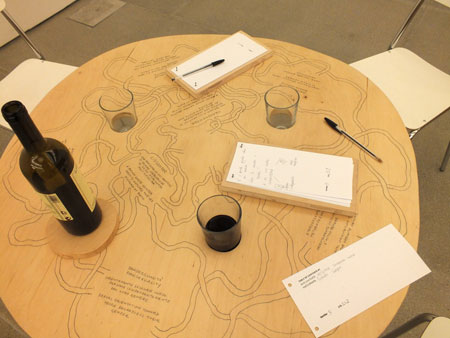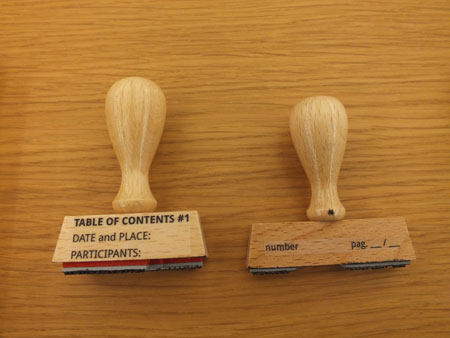
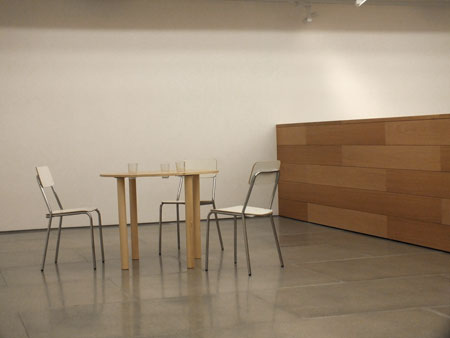
Table of Contents #1
Tavolo in legno, 100cm di diametro circa, 3 bicchieri, 3 tavolette, fogli di carta, penne. Sulle pareti sono appese le note prese dai_dalle partecipanti alle varie conversazioni. Veduta dell'installazione all'Accademia dello Scompiglio per "Assemblaggi provvisori", marzo 2016.
*
Le parole hanno una funzione descrittiva, riportano il reale, ma contemporaneamente lo plasmano. Sono il mezzo per creare un contatto e per poter condividere esperienze. Le parole hanno anche una valenza politica, sono necessarie per rivendicare diritti o per rivelare ingiustizie.
Le lingue sono dinamiche, nel senso che si modificano nel tempo, con l'uso, il variare del contesto. Ci sono parole che cadono in disuso (perchè inattuali), parole che cambiano di significato, e parole nuove (neologismi) che emergono dalla necessità di descrivere più appropriatamente (o in modo nuovo) aspetti del reale.
Le parole possono diventare etichette, clichè, ed inscatolare l'identità. Contemporaneamente è solo attraverso di essere che è possibile affermare un'identità altra, che differisce dall'implicito soggetto mainstream: uomo, bianco, eterosessuale, appartenente alla classe media.
Osservando il dibattito nei media italiani si nota una gran confusione su cosa certe parole significano e rappresentano. La confusione che ne emerge non è solo frutto di ignoranza, ma anche di manipolazione. Recentemente mi sono imbattuta spesso in una definizione fuorviante "ideologia di genere", in cui un campo di studi interdisciplinari dedicato appunto alla identità di genere e alla rappresentanzione del genere come categoria centrale di analisi socio-culturale viene storpiato in una presunta ideologia.
Il progetto Table of Contents #1 (tavola dei contenuti) è un installazione interattiva, un invito alla discussione e alla riflessione.
*
Sulla superficie del tavolo sono riportate le seguenti definizioni:
Transgender: una persona la cui identità di genere non corrisponde al sesso assegnato alla nascita.
Cisgender: una persona la cui identità di genere corrisponde al sesso assegnato alla nascita.
Ipsogender: una persona la cui identità di genere non corrisponde al sistema binario dei sessi assegnati alla nascita.
Eterosessualità, orientamento sessuale verso l’altro genere.
Omosessualità, orientamento sessuale verso lo stesso genere.
Bisessualità, orientamento sessuale sia verso l’altro genere che lo stesso genere.
Asessualità, una persona che non prova attrazione sessuale verso alcun genere.
Pansessualità, orientamento sessuale verso persone indipendentemente dal loro genere.
Table of Contents #1
Hand-drawn wooden table, approximately 100 cm in diameter, 3 glasses, 3 tablets, sheets of paper, pens. On the walls are hung the notes taken by the participants to the various conversations. Installation view at the Accademia dello Scompiglio for "Assemblaggi provvisori", march 2016.
*
Words have a descriptive function, they display the real, and at the same time they shape it. Words are the medium to create a contact and to share experiences. Words also have a political dimension, are necessary to claim rights or to reveal injustice.
Languages are dynamic, they change over time, with the use, and with the change of context. There are words that fall into disuse (because out of date), words that change meaning, and new words (neologisms) that arise from the need to describe more appropriately (or in a new way) aspects of reality.
Words can be labels, clichés, and boxing identity. At the same time it is only through them that we can affirm another identity, which differs from the implicit mainstream subject: man, white, heterosexual, middle-class.
Watching the debate in the media there is a lot of confusion about what certain words mean and represent. The confusion that emerges is not only the result of ignorance, but also of manipulation. Recently, in the italian context, I came across a misleading definition such as "gender ideology", in which a field of interdisciplinary studies precisely dedicated to gender identity and rappresentanzione as a central category of socio-cultural analysis is misunderstood as a supposed ideology.
The project Table of Contents #1 is an interactive installation, an invitation to discussion and reflection.
*
On the surface of the table, the following definitions are written:
Transgender: a person whose gender identity does not correspond to the sex assigned at birth.
Cisgender: a person whose gender identity matches the sex assigned at birth.
Ipsogender: a person whose gender identity does not match the binary system of sex assigned at birth.
Heterosexuality: sexual orientation toward the opposite gender.
Homosexuality: same-gender sexual orientation.
Bisexuality: sexual orientation toward the opposite gender and toward the same gender
Asexuality: a person who does not feel sexual attraction to any gender.
Pansexuality: sexual orientation towards people regardless their gender.
